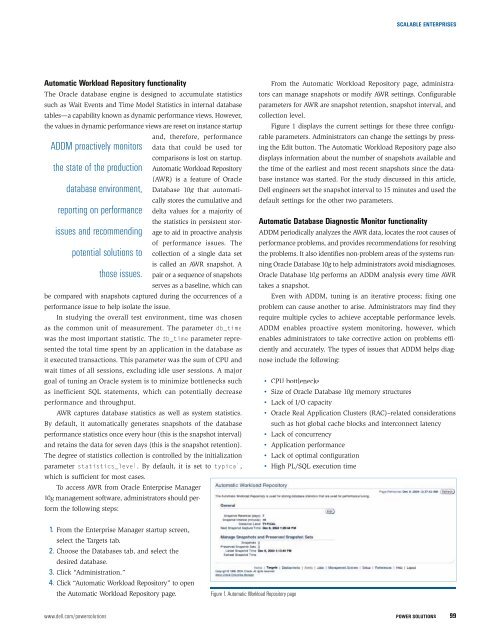Dell Power Solutions
Dell Power Solutions
Dell Power Solutions
- No tags were found...
Create successful ePaper yourself
Turn your PDF publications into a flip-book with our unique Google optimized e-Paper software.
SCALABLE ENTERPRISESAutomatic Workload Repository functionalityThe Oracle database engine is designed to accumulate statisticssuch as Wait Events and Time Model Statistics in internal databasetables—a capability known as dynamic performance views. However,the values in dynamic performance views are reset on instance startupADDM proactively monitorsthe state of the productiondatabase environment,reporting on performanceissues and recommendingpotential solutions toand, therefore, performancedata that could be used forcomparisons is lost on startup.Automatic Workload Repository(AWR) is a feature of OracleDatabase 10g g that automati-cally stores the cumulative anddelta values for a majority ofthe statistics in persistent storageto aid in proactive analysisof performance issues. Thecollection of a single data setis called an AWR snapshot. Apair or a sequence of snapshotsserves as a baseline, which canbe compared with snapshots captured during the occurrences of aperformance issue to help isolate the issue.In studying the overall test environment, time was chosenas the common unit of measurement. The parameter db_timewas the most important statistic. The db_time parameter representedthe total time spent by an application in the database asit executed transactions. This parameter was the sum of CPU andwait times of all sessions, excluding idle user sessions. A majorgoal of tuning an Oracle system is to minimize bottlenecks suchas inefficient SQL statements, which can potentially decreaseperformance and throughput.AWR captures database statistics as well as system statistics.By default, it automatically generates snapshots of the databaseperformance statistics once every hour (this is the snapshot interval)and retains the data for seven days (this is the snapshot retention).The degree of statistics collection is controlled by the initializationparameter statistics_level. By default, it is set to typical,which is sufficient for most cases.To access AWR from Oracle Enterprise Manager10g g management software, administrators should per-form the following steps:those issues.From the Automatic Workload Repository page, administratorscan manage snapshots or modify AWR settings. Configurableparameters for AWR are snapshot retention, snapshot interval, andcollection level.Figure 1 displays the current settings for these three configurableparameters. Administrators can change the settings by pressingthe Edit button. The Automatic Workload Repository page alsodisplays information about the number of snapshots available andthe time of the earliest and most recent snapshots since the databaseinstance was started. For the study discussed in this article,<strong>Dell</strong> engineers set the snapshot interval to 15 minutes and used thedefault settings for the other two parameters.Automatic Database Diagnostic Monitor functionalityADDM periodically analyzes the AWR data, locates the root causes ofperformance problems, and provides recommendations for resolvingthe problems. It also identifies non-problem areas of the systems runningOracle Database 10g g to help administrators avoid misdiagnoses.Oracle Database 10ggperforms an ADDM analysis every time AWRtakes a snapshot.Even with ADDM, tuning is an iterative process; fixing oneproblem can cause another to arise. Administrators may find theyrequire multiple cycles to achieve acceptable performance levels.ADDM enables proactive system monitoring, however, whichenables administrators to take corrective action on problems efficientlyand accurately. The types of issues that ADDM helps diagnoseinclude the following:• CPU bottlenecks• Size of Oracle Database 10g g memory structures• Lack of I/O capacity• Oracle Real Application Clusters (RAC)–related considerationssuch as hot global cache blocks and interconnect latency• Lack of concurrency• Application performance• Lack of optimal configuration• High PL/SQL execution time1. From the Enterprise Manager startup screen,select the Targets tab.2. Choose the Databases tab, and select thedesired database.3. Click “Administration.”4. Click “Automatic Workload Repository” to openthe Automatic Workload Repository page.Figure 1. Automatic Workload Repository pagewww.dell.com/powersolutions POWER SOLUTIONS 99








